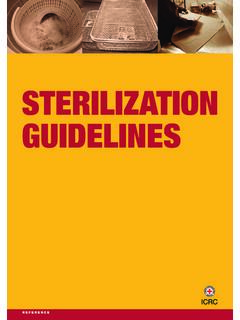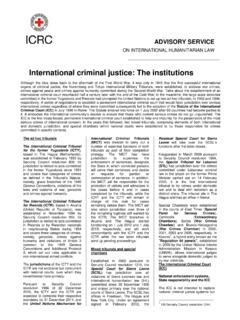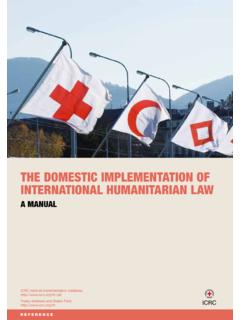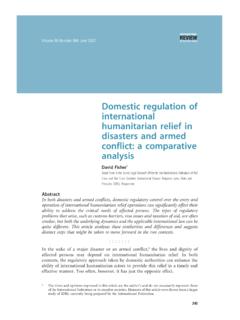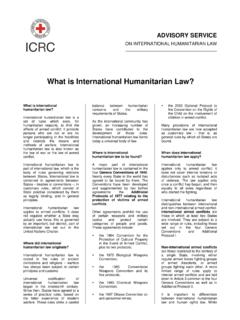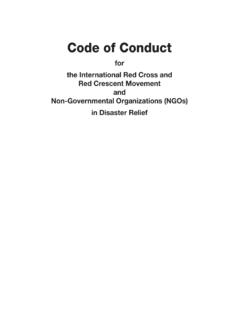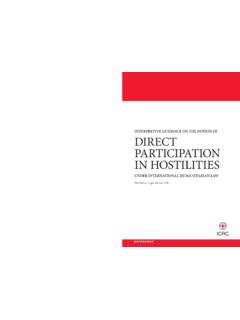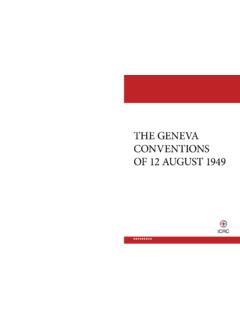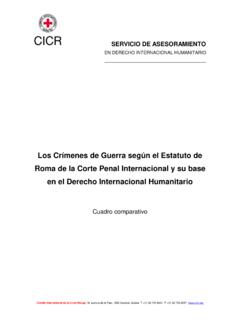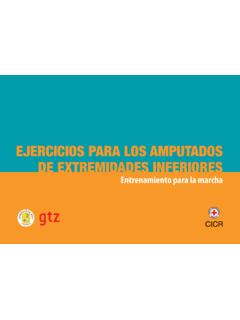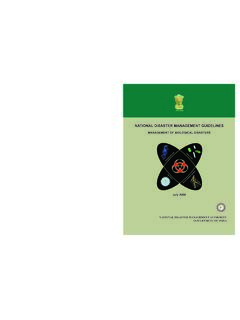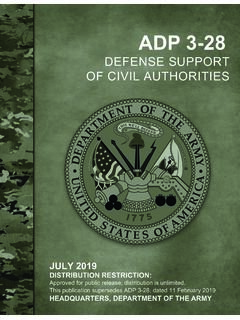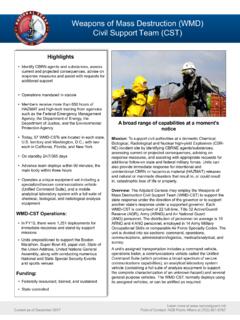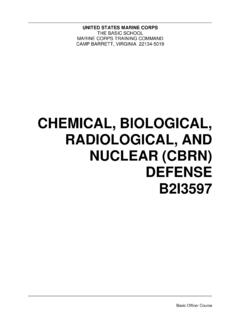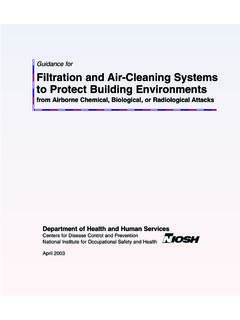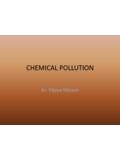Transcription of Medical waste management
1 Medical . waste . management . International Committee of the Red Cross 19, avenue de la Paix 1202 Geneva, Switzerland T +41 22 734 60 01 F +41 22 733 20 57. E-mail: ICRC, November 2011. Medical . waste . management . 2 Medical waste management . TABLE OF CONTENTS. PREFACE 6. 1. INTRODUCTION 8. 2. DEFINITION AND DESCRIPTION OF Medical waste 11. Description of Medical waste 12. Quantification of Medical waste 14. 3. Medical waste RISKS AND IMPACT ON HEALTH. AND THE ENVIRONMENT 15. Persons potentially exposed 16. Risks associated with hazardous Medical waste 17. Risks of trauma and infection 17. Survival of micro-organisms in the environment 19. Biological risks associated with exposure to solid household refuse 21.
2 chemical risks 21. Risks associated with the inappropriate processing and dumping of hazardous Medical waste 24. Incineration risks 24. Risks related to random disposal or uncontrolled dumping 25. Risks related to the discharge of raw sewage 25. 4. LEGISLATION 27. International agreements 28. National Legislation 30. TABLE OF CONTENTS 3. 5. FUNDAMENTAL PRINCIPLES OF A waste management . PROGRAMME 33. Assigning responsibilities 34. Sub-contracting, regional cooperation 37. Initial assessment 37. Preparing the waste management plan 38. Estimating costs 39. Implementing the waste management plan 40. 6. MINIMIZATION, RECYCLING 41. 7. SORTING, RECEPTACLES AND HANDLING 45.
3 Sorting principles 46. How to sort waste 47. Handling of bags 50. 8. COLLECTION AND STORAGE 51. 9. TRANSPORT 53. Vehicles and means of conveyance 54. On-site transport 55. Off-site transport 56. Cross-border transport 56. 4 Medical waste management . 10. TREATMENT AND DISPOSAL 57. Choosing treatment and disposal methods 58. Incineration 62. chemical disinfection 68. Autoclaving 69. Needle extraction or destruction 71. Shredders 73. Encapsulation 74. Disposal in a sanitary landfill or waste burial pit 75. Disposal of liquid wastes in the sewage 77. 11. STAFF PROTECTION MEASURES 79. Personal protective equipment 81. Personal hygiene 83. Vaccination 84.
4 Measures to be taken in the event of accidental exposure to blood 84. Emergency measures in the event of spills or contamination of surfaces 86. Emergency measures in the event that persons have been contaminated 88. 12. TRAINING 89. Why and how 90. Content 91. 13. FURTHER INFORMATION 93. TABLE OF CONTENTS 5. ANNEX 1 waste DATA SHEETS 95. Data sheet no. 1: Sharps (category 1) 96. Data sheet no. 2: waste entailing risk of contamination (category ) 98. Data sheet no. 3: Anatomical waste (category ) 100. Data sheet no. 4: Infectious waste (category ) 102. Data sheet no. 5: Pharmaceutical waste (category ) 104. Data sheet no. 6: Cytotoxic waste (category ) 106.
5 Data sheet no. 7: Mercury waste (category ) 108. Data sheet no. 8: Photographic development liquids (category ) 110. Data sheet no. 9: chemical waste (category ) 112. Data sheet no. 10: Pressurized containers (category 4) 114. Data sheet no. 11: Radioactive waste (category 5) 116. ANNEX 2 METHOD DATA SHEETS 117. Data sheet 12: Choosing sharps containers 118. Data sheet 13: Burial pit 120. Data sheet 14: Burial pit for anatomical waste 122. Data sheet 15 : Sharps pit 124. ANNEX 3 TOOLS FOR IMPLEMENTING THE waste . management PLAN 127. Annex Example of a form for quantifying waste generation 128. Annex Checklist for describing the current situation 129.
6 Annex Example of a waste flow diagram 134. Annex Audit checklist 135. Annex International transport of dangerous goods by road 145. Annex Example of a poster: What to do in the event of AEB 150. ANNEX 4 LIST OF SYMBOLS AND PICTOGRAMS 151. LIST OF TABLES AND FIGURES 156. LIST OF ABBREVIATIONS 158. 6 Medical waste management . PREFACE. The world is generating more and more waste and hospi- tals and health centres are no exception. Medical waste can be infectious, contain toxic chemicals and pose contamina- tion risks to both people and the environment. If patients are to receive health care and recover in safe surroundings, waste must be disposed of safely.
7 Choosing the correct course of action for the different types of waste and setting priorities are not always straightfor- ward, particularly when there is a limited budget. This manual provides guidance on what is essential and what actions are required to ensure the good management of waste . Drawing on the most up-to-date professional practice, the manual provides practical recommendations for use in the different contexts where the ICRC works. It includes techni- cal sheets ready for use, ideas for training and examples of job descriptions for hospital staff members. The guidance in this manual is applicable in resource poor countries as well as in countries where there is a more developed health infrastructure.
8 INTRODUCTION. The management of the waste from health services is complex and to be successful it must be understood and addressed by everyone working in health services from those washing the floors to the senior administrators. We hope that this manual will convince readers that the man- agement of Medical waste is an essential component of health facilities that must be a priority shared by ICRC staff and our valued partner organisations. Translating best practice for very different environments into clear and concise guidance for use by different profes- sions is a rare skill. This manual would not have been pos- sible without the expertise of Sylvie Praplan who has been the main partner and advisor in this adventure.
9 Thanks are also due to the expertise of many staff working in the field and in the Headquarters of the ICRC and in particular to Margrit Sch fer, in charge of Hospital Administration and Martin Gauthier, Environmental Engineer, for their perse- verance and guidance throughout the process. Elizabeth Twinch Head of Assistance Division International Committee of the Red Cross 8 Medical waste management . 1. INTRODUCTION. Health-care activities are a means of protecting health, curing patients and saving lives. But they also generate waste , 20 percent of which entail risks either of infection, of trauma or of chemical or radiation exposure. Although the risks associated with hazardous Medical waste and the ways and means of managing that waste are relatively well known and described in manuals and other literature, the treatment and elimination methods advocated require considerable technical and financial resources and a legal framework, which are often lacking in the contexts in which the International Committee of the Red Cross (ICRC) works.
10 The staff is often unequipped for coping with this task. Poor waste management can jeopardize care staff, employ- Hospitals are ees who handle Medical waste , patients and their families, responsible for the and the neighbouring population. In addition, the inap- waste they produce. propriate treatment or disposal of that waste can lead to They must ensure environmental contamination or pollution. that the handling, treatment and disposal In unfavourable contexts, the risks associated with hazard- of that waste will ous Medical waste can be significantly reduced through not have harmful simple and appropriate measures. This manual is intended consequences for as a practical and pragmatic tool for the routine manage- public health or the ment of dangerous hospital wastes.
